|
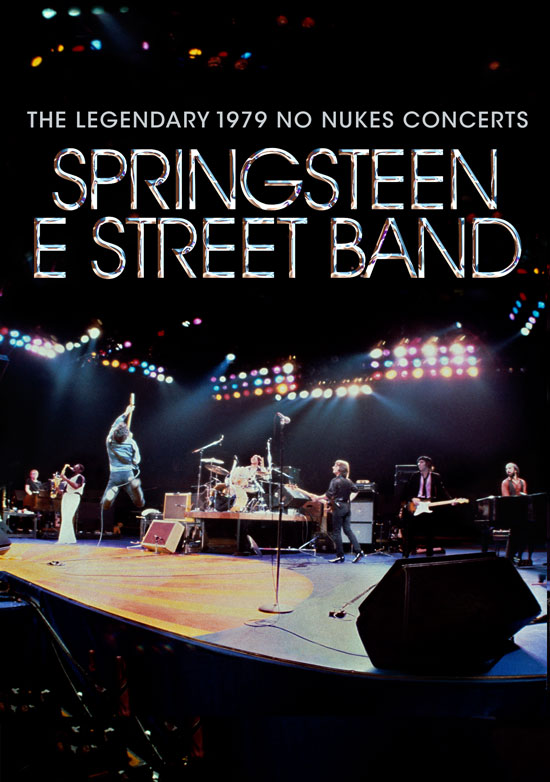
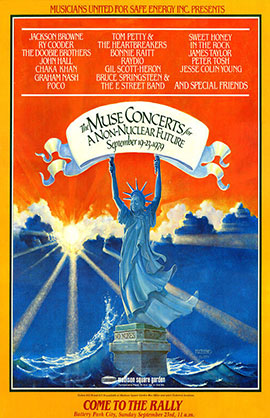 In their new film The Legendary 1979 No Nukes Concerts, executive producer Bruce Springsteen and editor Thom Zimny rescue long-buried footage of Springsteen and the E Street Band's two headlining sets from the all-star benefit concerts staged by Musicians United for Safe Energy (MUSE). Stitching together one complete concert out of the September 21 and 22 Madison Square Garden shows, The Legendary 1979 No Nukes Concerts decisively earns the adjective in its title. It's a 90-minute distillation of what made Springsteen and the E Street Band the most thrilling live rock 'n' roll band of the day. In their new film The Legendary 1979 No Nukes Concerts, executive producer Bruce Springsteen and editor Thom Zimny rescue long-buried footage of Springsteen and the E Street Band's two headlining sets from the all-star benefit concerts staged by Musicians United for Safe Energy (MUSE). Stitching together one complete concert out of the September 21 and 22 Madison Square Garden shows, The Legendary 1979 No Nukes Concerts decisively earns the adjective in its title. It's a 90-minute distillation of what made Springsteen and the E Street Band the most thrilling live rock 'n' roll band of the day.
These were their only public performances while otherwise ensconced in the studio that year, recording what would become The River at New York's Power Station. Springsteen's sets on both nights were capped at an hour and a half, which means the No Nukes concerts were only approximately half as long as what his fans were accustomed to from the preceding tour for Darkness on the Edge of Town. Yet, somehow, all the touchstones — "Born to Run," "Badlands," "Thunder Road," "Rosalita," "Jungleland," the "Detroit Medley" — are still there, all performed at full throttle. The Legendary 1979 No Nukes Concerts works as a representative document of the moment in Springsteen's career when he had solidified his reputation as an electrifying live performer with a smoking-hot band. You could show this film to anybody — old fans, non-fans, your grandkids, an extraterrestrial from Mars — and tell them "THIS was Bruce Springsteen and the E Street Band," and they'd understand.
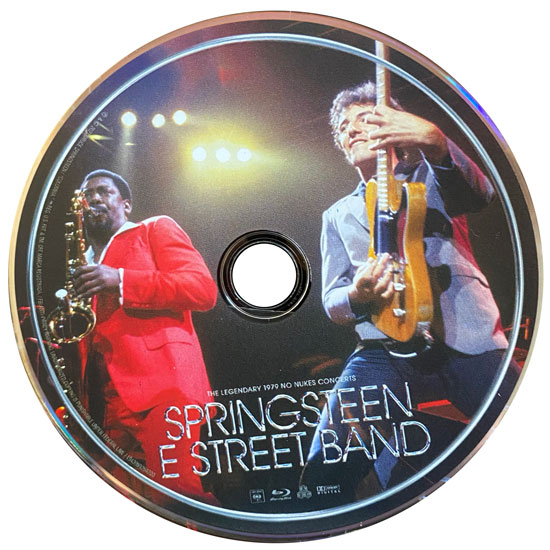
The Blu-ray disc of the new film, photograph by Richard E. Aaron
In The Legendary 1979 No Nukes Concerts, Springsteen hits the stage for the first song, "Prove It All Night," like he was shot out of a cannon. A huge grin on his face, he flashes his guitar like, well, a switchblade; he's spinning, windmilling, running all over the stage, flirting with the front row. And his manic energy is contagious. What a kick it is to see this iteration of the E Street Band together again, with Clarence Clemons in his sax-wailing, hype man prime (his sinuous, velvety solo on "Jungleland" might be the definitive live version), and Danny Federici grooving behind his banks of organs, stepping out to sing doo-wop backing vocals with Clarence on "Quarter to Three." Decked out in Mean Streets-meets-R&B-revue sartorial splendor, the E Street Band follows its leader down all of his frenzied alleys of spontaneity, while remaining impeccably tight and playing at a tempo to rival that of any punk band.
The film is all the more important because of the scarcity of pro-shot E Street Band concerts from this period. In a recent Rolling Stone interview about the new release (the film coincides with a soundtrack album on CD or vinyl), Springsteen explained that he shied away from film and TV back then because he believed that they were "cool" (as in temperature) mediums unsuited to capturing the heat of an E Street Band show. But the 16 mm footage from which Zimny fashioned the new film has a gorgeous retro warmth, thanks to the original 1980 No Nukes documentary's cinematographer, Academy Award-winner Haskell Wexler. The sound is newly remixed by Springsteen's go-to sonic wizard, Bob Clearmountain.
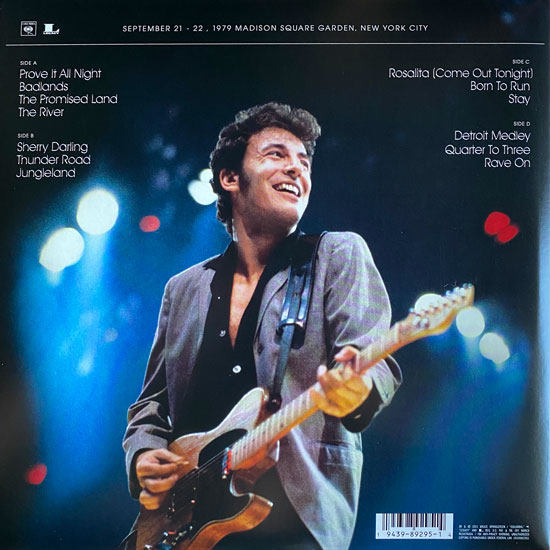
The back jacket of the 2LP sountrack, photograph by Joel Bernstein
Additionally, the original No Nukes shoot used hand-held cameras positioned in the front row and stage level, so you're seeing the show as if you're in the pit, close enough to read the expressions on Bruce's face and capture the eye contact between band members. There's nothing to interrupt the performance in The Legendary 1979 No Nukes Concerts, no narration or interviews, just Springsteen and the E Street Band playing their butts off. Contrary to what Springsteen thought about the iciness of film at the time, if The Legendary 1979 No Nukes Concerts were any hotter, it would melt your eyeballs. The movie pulls you into the past and exhilaratingly conveys what it looked, felt, and sounded like on those two nights at Madison Square Garden. And I know, because I was there for one of them.
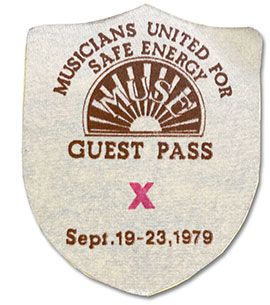 I got sucked into the whirlwind when I saw my first Springsteen shows on the Darkness tour in 1978. In September 1979, I was jonesing for more. My friend and fellow Springsteen fan Holly Cara Price had moved from Boston to New York to pursue her passions — photography, poetry, and rock 'n' roll. One day she called me with the miraculous news that she had scored tickets to the No Nukes show on September 22, Bruce's birthday eve, courtesy of Asbury Park legend/Springsteen mother hen Obie Dziedzic. I was 22 years old, freshly graduated from Boston University, trying to become a rock critic. I pitched a review to my editor at a free Boston music paper and boarded the Amtrak for my first trip ever to New York City. I was so unseasoned as a traveler that I couldn't figure out how to get from the train up to the main level of Penn Station. Holly, waiting upstairs, had to have me paged to pick up the courtesy phone. I got sucked into the whirlwind when I saw my first Springsteen shows on the Darkness tour in 1978. In September 1979, I was jonesing for more. My friend and fellow Springsteen fan Holly Cara Price had moved from Boston to New York to pursue her passions — photography, poetry, and rock 'n' roll. One day she called me with the miraculous news that she had scored tickets to the No Nukes show on September 22, Bruce's birthday eve, courtesy of Asbury Park legend/Springsteen mother hen Obie Dziedzic. I was 22 years old, freshly graduated from Boston University, trying to become a rock critic. I pitched a review to my editor at a free Boston music paper and boarded the Amtrak for my first trip ever to New York City. I was so unseasoned as a traveler that I couldn't figure out how to get from the train up to the main level of Penn Station. Holly, waiting upstairs, had to have me paged to pick up the courtesy phone.
One thing the no-narration structure of The Legendary 1979 No Nukes Concerts isn't able to do is give you a full sense of how much of a Springsteen crowd this was inside Madison Square Garden on Sept. 21 and 22 (the two Springsteen-topped shows were the only sellouts of the five MUSE shows). On the night I was there, the great Peter Tosh and Gil Scott-Heron were pretty much ignored; cries of "Broooce" could be heard between every song of Bonnie Raitt's and Tom Petty and the Heartbreakers' sets. By the time the E Street Band took the stage at 11:45 p.m., we had already been waiting for more than four hours, and the Garden was vibrating — actually shaking — from the foot-stomping of the crowd. There was an almost palpable anticipation running through the hall that something wild was about to happen during Springsteen's birthday show.
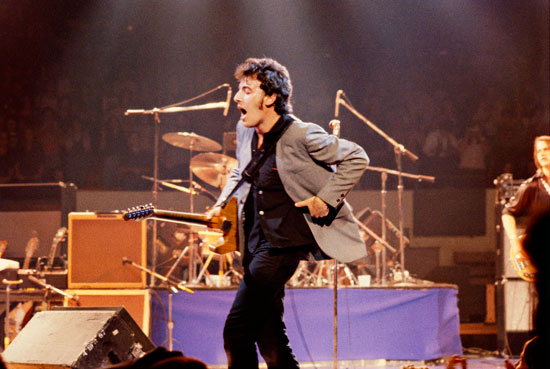
Photograph by Lawrence Kirsch
In The Legendary 1979 No Nukes Concerts, you see some of the mayhem unleashed at midnight, right after the band finished "The Promised Land." Someone in the audience tries to hand Springsteen a chocolate birthday cake. "Don't remind me," he can be heard saying, then promptly flings the cake up and over the crowd. (I couldn't see where it landed that night — maybe it's still hovering in the air, like Prince's guitar.) "Send me the laundry bill," Springsteen snaps, licking frosting off his hand. The cake toss was weird and a little unsettling at the time and still looks that way on film. (Not shown and not missed: The Lynn Goldsmith Incident later that night, in which Springsteen pulled his ex-girlfriend onto the stage and had her ejected for shooting unauthorized photos.) After the cake toss, Springsteen shuts down any further celebration by introducing the as-yet unreleased and unheard "The River," an audacious move given that he had a full Garden primed to party.
That night, Holly and I and our friends sat transfixed up in our side-stage rafter seats, hanging on to every unfamiliar lyric of "The River," stunned by the intensity of the story we were hearing for the first time. I scribbled down the words: "I got Mary pregnant," "lately there ain't been much work on account of the economy," "is a dream a lie if it don't come true / or is it something worse…." It had the shape of a folk song, but with a harder edge.
In the film, Springsteen is in tight closeup for much of "The River" as he slips into the skin of the song's narrator. It's not, though, as unrelenting a closeup as in the 1980 No Nukes film. Zimny has found full-length shots of Springsteen during "The River" where he grips the mic stand at a tilt, like Elvis Presley — but he's not singing about hound dogs or teddy bears. There is coiled tension in his pose. The comparison between the 1980 edit of "The River" and the new one not only reveals Zimny's skill as an editor, juggling footage from multiple cameras and two nights, it speaks to how attuned Zimny is to the meaning of this performance in this moment. The full-length shot reveals Springsteen delivering an angry reading of "The River" for its debut, a young man's reading, filled with bewilderment and a sense of betrayal at how quickly the promised land was snatched from his grasp. In the Garden that night, as Springsteen sang that last chilling verse about a dry riverbed, paradise lost, Holly and I looked at each other and neither one of us could speak.
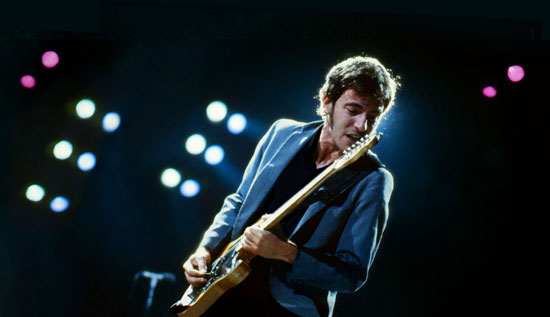
Photograph by Joel Bernstein
After "The River," Springsteen lightens up, cracking, "I'm over the fucking hill. I can't trust myself anymore," a reference to the '60s counterculture slogan "Never trust anybody over 30." Then he swings into "Sherry Darling," another song from what would be "The River" album (though previously performed on the '78 tour), and it's party time at last. There's a great visual on "Sherry" when Bruce shouts "One more time for the guys back there!" and the band turns and plays to the sections going crazy behind the stage; as I recall, they were the only performers to acknowledge those audience members all night.
As the last song of the set before their encore, "Rosalita" (from Sept. 21) captures Springsteen and the band at the height of showmanship, with all the antics that had become staples of their live shows: Bruce and Clarence's gunslinger routine, their goofy prance across the stage to Roy Bittan's piano vamp, Bruce sliding on his knees to end up at Clarence's feet, the "King of the Known World, Master of the Universe" band intros. Springsteen can't stop dancing, even during the band intros. By the end of the song, he's doing laps around the stage, jumping on and over everything in his path, like a zoo monkey bouncing off the bars of his cage. And the Garden was bouncing with him.
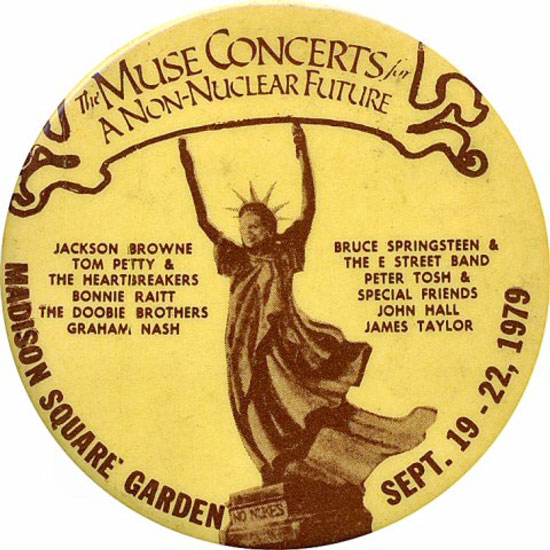
The last third of the movie is made up of encores, beginning with the Sept. 22 performance of "Stay," Jackson Browne's hit cover of the Maurice Williams and the Zodiacs song, with the E Street Band joined by Browne, vocalist Rosemary Butler, and Tom Petty (cigarette dangling from his mouth, because this was the '70's). And then it's a frenetic "Detroit Medley" from the Sept. 21 show and a roof-blasting "Quarter to Three" from Sept. 22, which together contain every classic Bruce shtick of the era, including the James Brown-inspired fake faint and "I'm just a prisoner of rock 'n' roll" resurrection, and false ending after false ending after false ending. And when you think the movie is over, there's a false ending there, too, with Bruce and the band returning for Buddy Holly's "Rave On" (from Sept. 21). In so doing, this film composite covers every song Bruce and the band played over both nights.
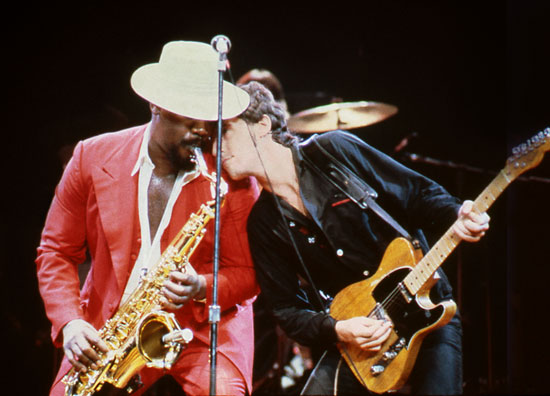
Photograph by Joel Bernstein
I watched The Legendary 1979 No Nukes Concerts in an emotional jumble of bliss and heartache. Clarence is gone. Danny is gone. Holly, who went on to become Steve Van Zandt's assistant and lived the righteous life of a true disciple of soul, passed on November 7, 2020, after a ferocious battle with breast cancer. It would be easy to let this film send you into a state of melancholia. But the past decade or so of Springsteen fandom has been all about melancholia. Yes, it's necessary to acknowledge mortality, absent friends, and the passage of time, and it has been brave of Bruce to tell us in his recent work exactly how lonely it can feel to grow old. But frankly, it's been a bitch of a year, or five, and I don't know about you, but I can't look back in tears anymore. The Legendary 1979 No Nukes Concerts gives us the perfect opportunity to cut loose and feel joy again. Although I was at one of these shows, my memories of it have gotten fuzzy. What a gift, then, to be able to rewind time and relive this show, to see that it wasn't a dream, that we really were this young and there really was magic in the night.

Joyce Millman is a longtime music critic and Springsteen fan. Her essay “A Map of the Future” appears in Eric Meola’s book Streets of Fire: Bruce Springsteen in Photographs and Lyrics 1977-1979. Follow her on Twitter at @joycemillman.
The Legendary 1979 No Nukes Concerts is available now on CD/DVD, CD/Blu-ray, and 2LP vinyl (soundtrack only) from Backstreet Records, as well as on digital.
|






